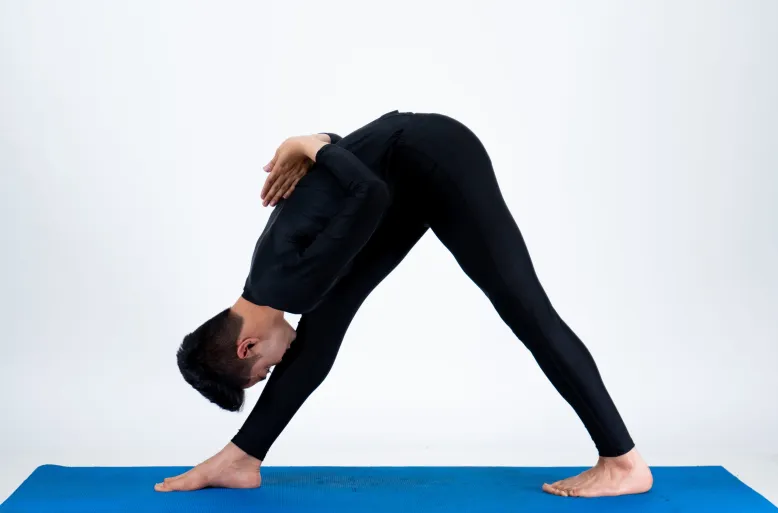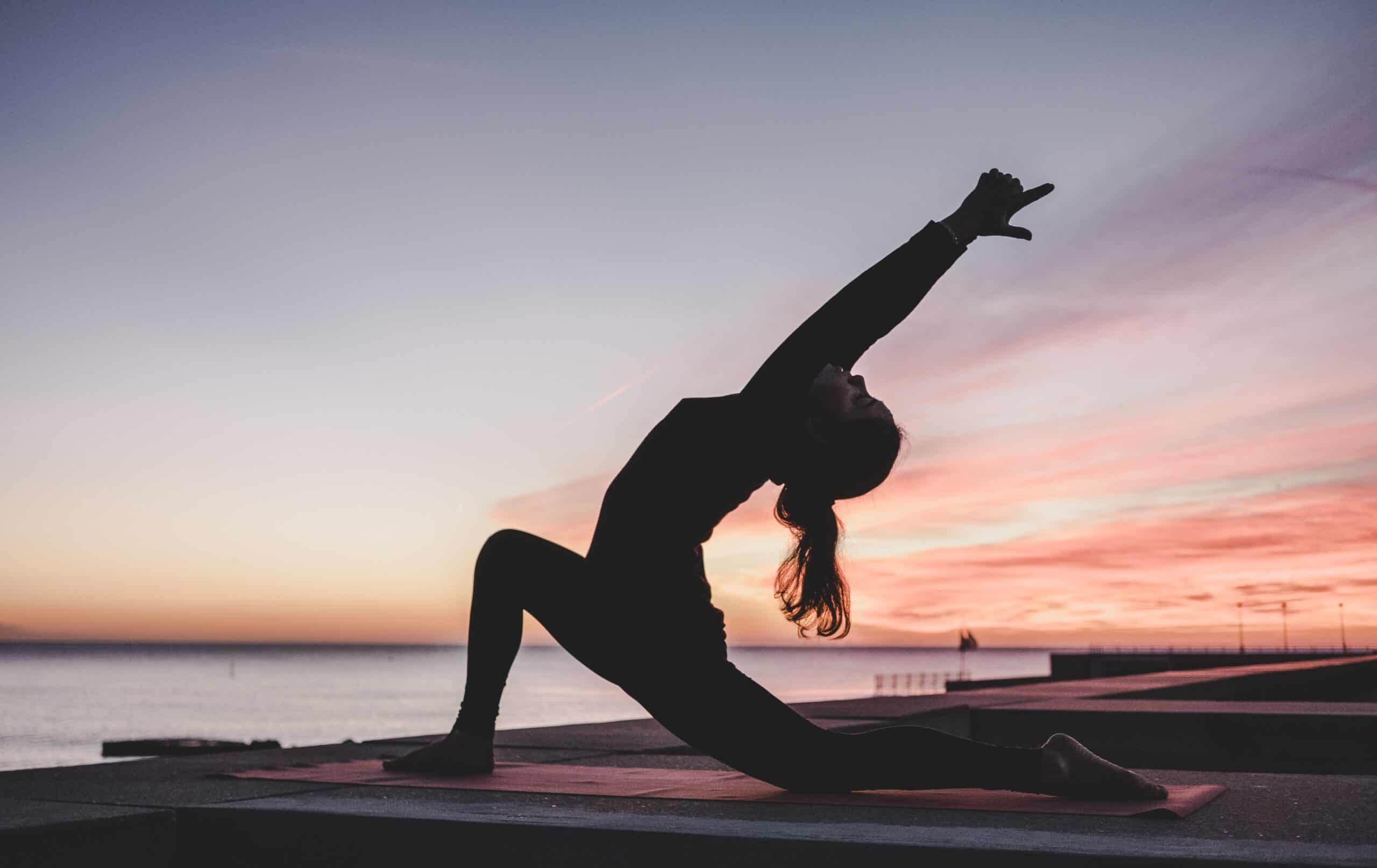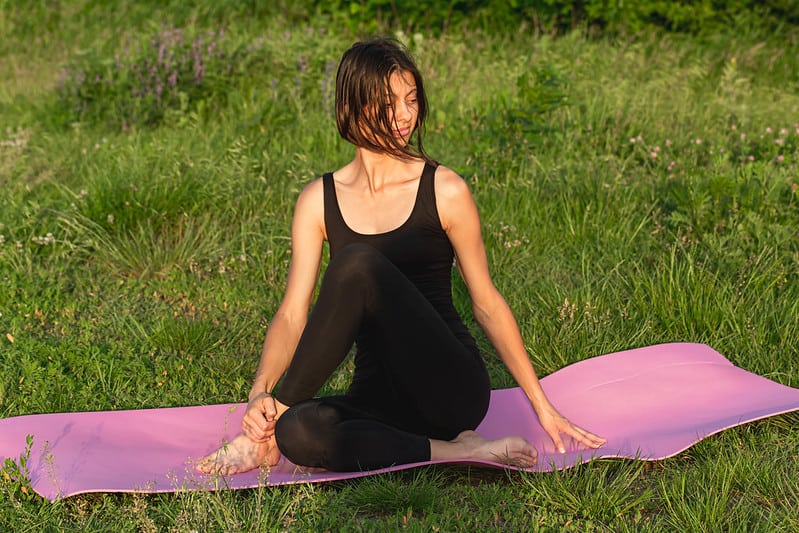Parsvottanasana, also known as Intense Side Stretch Pose, is a foundational asana in yoga.
In Sanskrit, “Parsva” denotes side, “Uttana” indicates severe stretch, and “Asana” means posture or position. This position is renowned for its ability to develop strength, flexibility, and attention while also offering a deep stretch to the sides of the body.
Rooted in the Hatha Yoga tradition, Parsvottanasana is significant not just for its physical advantages, but also for its profound impact on mental and emotional well-being. In this thorough examination, we look at the anatomical alignment, variations, benefits, and spiritual core of Parsvottanasana.
Benefits of Parsvottanasana:
Parsvottanasana has several physical, mental, and emotional advantages, making it an excellent complement to any yoga practice. Some of the primary benefits are:
- Hamstring Flexibility: The powerful stretch along the back of the legs in Parsvottanasana lengthens and releases tension in the hamstrings, increasing flexibility and range of motion.
- Hip Opening: This posture stretches the hip flexors and quadriceps in the rear leg, increasing hip flexibility and mobility.
- Spinal Extension: Parsvottanasana lengthens the spine and develops the muscles in the back, encouraging good posture and spinal health.
- Improves Balance and Attention: Maintaining posture demands attention and focus, which promotes mental clarity and balance both on and off the mat.
- Maintaining the perfect position in Parsvottanasana strengthens the legs, core, and glutes, increasing overall stability and support.
- Stimulates Abdominal Organs: Compressing the belly in the front fold stimulates the digestive organs, facilitating digestion and cleansing.
- Reduces Stress and Anxiety: Parsvottanasana’s attentive breathing and meditation components serve to quiet the mind, lower stress, and promote relaxation.
The Spiritual Benefits of Parsvottanasana:
Beyond its physical advantages, Parsvottanasana has a deeper spiritual meaning in the practice of yoga. As with other yoga positions, the term itself has symbolic value. “Parsva” means side or flank, symbolizing duality and the necessity to balance conflicting energies.
The term “uttana” refers to an extreme stretch or extension, implying that awareness may expand beyond physical limits. As they traverse the difficulties of Parsvottanasana, the practitioner is encouraged to consider the interaction between strength and surrender, effort and ease.
The body position of Parsvottanasana embodies the concepts of Sthira and Sukha, or stability and ease. While the position needs strength and stability, it also promotes gentleness and surrender. Finding a balance between these conflicting elements is a metaphor for achieving peace in life, both on and off the mat.
Parsvottanasana is also related to the activation of the Manipura Chakra, also known as the solar plexus chakra, which is located in the navel center. This energy area is associated with personal strength, willpower, and self-esteem. By engaging the core and establishing inner strength in Parsvottanasana, practitioners may tap into the transforming energy of the Manipura Chakra, allowing them to overcome barriers and realize their objectives.
Integrating Parsvottanasana into your practice
Parsvottanasana may be an effective supplement to many yoga routines. Here are a few ways to include it:
- Warm up your hamstrings and spine with preparatory postures such as Uttanasana (Forward Fold) or Downward-Facing Dog before moving on to Parsvottanasana.
- Standing Flow: Incorporate Parsvott
Unveiling the Pose: Step by Step
- Begin by centering yourself in Tadasana (Mountain Pose). Stand tall with your feet hip-width apart, pushing hard into the ground. Engage your core and extend your spine.
- Step Back: Take a big step back with your right foot, around 3-3.5 feet. Make sure your heels are straight and your front foot is pointing directly front.
- Torso Alignment: Hinge at the hips to maintain your spine long. Reach your torso forward and stretch it over your front thigh. Avoid circling the back.
- Reaching for Depth: Lower your hands towards the floor, eventually laying your palms flat alongside your front foot. If this feels unreachable, place your hands on blocks or softly on your shins.
- Maintain a straight back leg and drive your heel firmly into the ground. Avoid locking your knees.
- Finding Your Balance: To ensure stability, distribute your weight evenly between both feet.
- Reaching Back (Optional): To get a deeper stretch, try reaching your hands behind your back. Interlock your fingers or clasp your wrists. Maintain a flat back and an extended neck.
- Head Position: Relax your head and neck, letting them hang heavily. Rest your forehead against your shin or a block, if necessary.
- Throughout the position, take the calm, deep breaths. Inhale as you lengthen your spine; exhale as you relax further into the stretch.
- Holding and Transitioning: Take 5-10 breaths in the position, concentrating on your body’s feelings. To release, press strongly onto your front foot as you return to Tadasana. Repeat on the opposite side.
Conclusion:
Parsvottanasana, or Intense Side Stretch Pose, provides a profound path of inquiry and change for yoga practitioners of all levels. This posture expands the body, soothes the mind, and feeds the soul with attentive alignment, focused breath, and profound surrender. Yoga’s physical postures remind us of the connectivity of mind, body, and spirit, as well as the boundless potential that each of us possesses. The practice of Parsvottanasana involves not only
Frequently Asked Questions?
What is the benefit of Parsvottanasana?
Pyramid Pose, also known as Parsvottanasana or Intense Side Stretch Pose, is a yoga pose that offers numerous physical, mental, and emotional benefits. It provides an intense stretch to the hamstrings of the front leg, improving flexibility. It also improves hip flexibility and mobility. Pyramid Pose also involves a forward fold, which lengthens the spine and stretches muscles along the back. It strengthens legs and core muscles, improving lower body strength and stability. Balancing in Pyramid Pose requires focus and concentration, enhancing mental clarity and body awareness. It stimulates the abdominal organs, promoting detoxification and reducing stress and anxiety. Pyramid Pose is often included in dynamic sequences or flow practices, boosting circulation and energy flow. It promotes a mind-body connection, deepening awareness and presence in the present moment.
What is the alignment of Parsvottanasana?
It involves stretching the hamstrings, hip opening, and spinal extension while maintaining proper alignment and focus. The forward fold stimulates digestion and reduces tension. Pyramid Pose promotes inner peace, and mindfulness, and deepens awareness. To maximize its benefits and prevent injury, practitioners must practice with precision, focusing on alignment from feet to head.
What is the primary movement of Parsvottanasana?
Parsvottanasana, also known as Intense Side Stretch Pose or Pyramid Pose, is a pose that involves a deep forward fold from the hips while maintaining length and extension through the spine. This pose is characterized by hip hinging, spinal extension, engagement of core and leg muscles, surrender and relaxation, and mindful breathing. The forward fold involves a deep stretch to the hamstrings, hips, and sides of the torso while promoting spinal extension and alignment. The pose requires strength, flexibility, and mindfulness to execute the forward fold with proper alignment and awareness. Over time, deepening into the pose may lead to increased flexibility, improved posture, and a sense of groundedness and calm.
What is the history of Parsvottanasana?
Parsvottanasana, a yoga asana, is rooted in ancient Indian yogic tradition and philosophy. It has evolved over thousands of years, with each posture having a rich history. The Vedas emphasize spiritual discipline, meditation, and self-realization. The Yoga Sutras of Patanjali codified philosophical principles, while Hatha Yoga focused on purifying the body and mind. Parsvottanasana, also known as “Intense Side Stretch Pose,” continues to inspire and empower individuals on their yoga journey.





No Comments